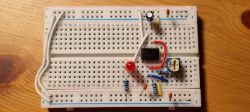elektronik.b wrote: And if you are so smart, find it yourself.
I? I do not have to. I don't make useless devices that do nothing but wag directions - quite pointless after all.
yogi009 wrote: the first cats behind the fences. You will do the next DIY on one PCB, you will add the possibility of calibration there, and if such a PCB fits dimensionally with the "back" of the indicator, it will be too much luck.
Well, unfortunately, it is not so. A colleague has already placed a few constructions in DiY and somehow he did not draw any conclusions from the suggested changes. Yes, this "Krakow" is a bit neglected ...
elektronik.b wrote: I was looking and the only simple system I found was the one from the first post, the rest did not work for me.
Interesting, isn't it? And what other systems (those that did not want to work) did you make? Maybe it would be enough to think why they don't work, ask someone ... wiser ...?
bratHanki wrote: For decades, simple control systems have been used in tape recorders (conveyor belts) produced by us and not only, and somehow no one was picking on,
Because they worked as they should. Small difference...
I wrote earlier:
398216 Usunięty wrote: CodeBoy wrote: I don't like something about the scaling of the excursions, they work too much on the positive half of the scale, they should start more around -20 and move around 0dB
In general, the time from the occurrence of a signal of a given level to its indication, as well as the time in which the indication falls after the signal ceases, is quite strictly defined for this type of indicators. Here it is just something that fans the clues to the beat of the music. There is no practical benefit from this.







